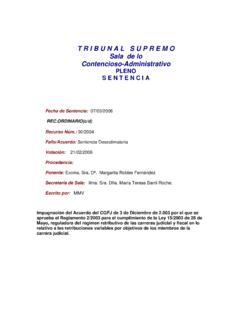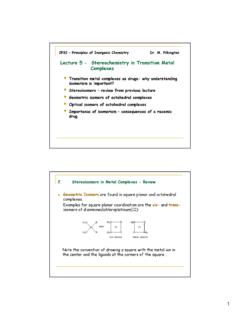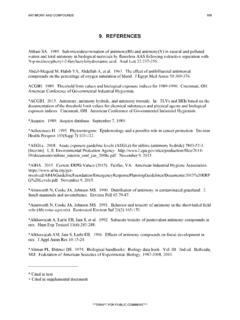Transcription of IS EPIZOOTIC RABBIT ENTEROPATHY (ERE) A BACTERIAL …
1 Pathology and Hygiene 971 IS EPIZOOTIC RABBIT ENTEROPATHY (ERE) A BACTERIAL disease ? Huybens *, Houeix , Szalo , Licois , Mainil , Marlier 1 Department of Clinical Science, University of Liege, 20 boulevard de Colonster, 4000 Li ge, Belgium 2 Animal Infectious Diseases and Veterinary Public Health Research Unit, Bat 213, INRA, 37380 Nouzilly, France 3 Department of infectious and parasitic diseases, University of Liege, 20 boulevard de Colonster, 4000 Li ge, Belgium *Corresponding author: ABSTRACT The etiology of EPIZOOTIC RABBIT ENTEROPATHY (ERE) is still unknown despite ten years of continuous research. A putative BACTERIAL etiology is at the basis of current research. The fractionation of the reference inoculum (TEC4) is a major step to find the potential BACTERIAL agent(s).
2 In this study, TEC4 was fractionated with two techniques: centrifugation on discontinuous sucrose gradient then cell adhesion. Two selected fractions were inoculated to SPF rabbits and analyzed with classical bacteriological techniques. ERE was reproduced with both fractions. The 16S rDNA gene was amplified in all fractions and in three negative controls and subsequently analyzed with Restriction Fragment Length Polymorphism (RFLP) and Denaturating Gradient Gel Electrophoresis (DGGE). A difference in BACTERIAL DNA composition was found between virulent and non-virulent fractions which reinforce the potential role of bacteria in the etiology of ERE. Keywords: ERE, Fractionation, Bacteria, DGGE, RFLP. INTRODUCTION EPIZOOTIC RABBIT ENTEROPATHY (ERE) is a digestive syndrome that has spread throughout Europe since 1997 (Duval, 1998; Marlier and Vindevogel, 1998).
3 This pathology induces a decrease in food and water intake with a high mortality rate. Other clinical signs sometimes observed are: aqueous diarrhea, caecal impaction, rambling noise, etc. Typical lesions observed at necropsy are overfull anterior digestive tract, stomach included, without inflammation process (Licois et al., 2005). Bacitracine and tiamuline are the only known effective treatment. Unfortunately, mortality may start again by the end of the treatment (Maertens et al., 2005). ERE is the first cause of mortality in European RABBIT industry and cost approximately ten millions of euros yearly in Belgium (Dewree et al., 2003). Although it is commonly accepted that ERE is an infectious disease , the etiological agent is still unidentified today (Licois, 1998; Licois et al.)
4 , 2000; Marlier et al., 2006; Szalo et al., 2007). An inoculum (TEC) made from digestive contents of ERE dead rabbits systematically reproduces the pathology (Licois and Coudert, 2003), first generation of TEC was TEC1 and last is TEC4. Szalo et al (2007) fractioned TEC3 with a centrifugation on discontinued gradient sucrose. The inoculation on SPF RABBIT showed that 30% fraction and pellet reproduce the pathology whereas supernatant does not reproduce (Szalo et al., 2007). The aims of this study are fractionate TEC4 (Licois and Coudert, 2005) and analyzing its BACTERIAL flora to prove that the etiological agent is one or several bacteria. MATERIALS AND METHODS Inoculum and culture cells TEC4 was first fractionated by the technique described by Szalo et al. (2007). The 50% fraction of the centrifugation (50%) was then used for a second fractionation using RABBIT kidney cells (RK13 cells).
5 9th World RABBIT Congress June 10-13, 2008 Verona Italy 972 Twenty-four hours before cell inoculation, the culture medium of a confluent box of 75 cm2 was changed for a medium without antibiotic. Twenty-four hours later, the culture medium was discarded and 1 ml of 50% fraction was added on the cells. After 4 h at 37 C, culture was rinsed three times with sterile PBS to wash out non adherent bacteria. Cells and adherent bacteria were then scraped with a cell scraper then suspended in 1 ml of antibiotic free medium. This inoculum was named RK501 and stored at -20 C. Reproduction of the disease Fifty-four 4-weeks old rabbits were randomly allocated to 3 batches with each batch split in 6 cages of 3 rabbits. After one week of acclimatization, batch one was inoculated per os with 100 l/ RABBIT of 50%, batch two with 100 l/ RABBIT of RK501 and batch three with 100 l/ RABBIT of SPF RABBIT s caecal content (negative control).
6 Each RABBIT was weighted at D-7, D-4, D0, D3, D6, D8, D10 and D13. Mortality and presence of diarrhea were written down each day. Statistical analyses were performed with SAS (Statistical Analysis System, 2000). Linear model with Repeated Measures was used with as effects treatment, day and interaction between both. Bacteriological analyses Ten l of each fraction were inoculated onto agar plates and incubated for 24 h at 37 C, aerobically on 5% sheep blood agar and anaerobically (80% N2, 10% CO2 and 10% H2) on 5% sheep blood agar and Schaedler agar. Individual colonies were identified using standard procedure and commercial galleries (API Strep, Rapid ID 32A and Api 20 NE from BIOMERIEUX). Bacterioscopic analyses The bacterioscopic analyses were performed as described in Szalo et al. (2007). Restriction Fragment Length Polymorphism (RFLP) Total DNA was extracted from TEC3, TEC4, the seven sucrose fractions, RK501 and caecal contents of 3 healthy rabbits (TEM1, TEM2, TEM3) with QIAamp DNA Stool Mini Kit (Qiagen) following manufacturer instructions.
7 The 16S rDNA genes were amplified by PCR with universal primers (5 -AGAGTTTGATCMTGGCTCAG-3 and 5 -TACGGYTACCTTGTTACGACTT-3 ). Amplification conditions were 30 cycles with 30s at 94 C, 30 s at C and 90 s at 72 C, with an initial denaturation and a final elongation of 5 min. PCR products were dialyzed on 0,025 m membrane (Millipore) and DNA concentration was measured with spectrophotometry at 260 nm. Each sample was digested with 13 different restriction enzymes (Acc I, Alu I, Ava II, Cfo I, Cla I, EcoR I, Hpa I, Msp I, Pvu II, Rsa I, Sal I, Sau3AI and Taq I). One microgram of purified DNA was digested with 1 U of enzyme and 2 l of enzyme buffer in 20 l total volume during 1 h at enzyme specific temperature. Profiles were analyzed with the Bio-Gene software (Vilber Lourmat ).
8 Denaturating Gradient Gel Electrophoresis (DGGE) V3 region of 16S rDNA was amplified by a nested-PCR. The first PCR, with primers 5 -AGAGTTTGATCM TGGCTCAG-3 and 5 -TACGGYTACCTTGTTACGACT T-3 , amplified the whole gene. Amplification conditions were 17 cycles with 30 s at 94 C, 30 s at C and 90 s at 72 C. The second PCR amplified V3 region with primers 5 -CGCCCGCCGCGCGCGGCGGGCGGGGCG GGGGCACGGGGGGCCTACGGGAGGCAGCAG 3 and 5 -ATTACCGCGGCTGCTGG-3 . Amplification conditions were 35 cycles with 30 s at 94 C, 30 s at 55 C and 60 s at 72 C, with an initial denaturation and a final elongation of 5 min for the two PCR. DGGE was performed using DCode System (Bio-Rad Laboratories, USA) onto 8% polyacrylamide gel in 1x Tris-acetate-EDTA buffer (TAE), which contained a 35-55% denaturant gradient (100% denaturant, 7 M Urea and 40% (v/v) deionised formamide).
9 Forty microlitres of PCR Pathology and Hygiene 973 products were loaded on the gel and run 5 h, at constant temperature and voltage (60 C and 130V). Gel was revealed with 2 l GelStar Nucleic Acid Gel Stain in 15 ml of distilled water. Interesting bands were excised and immersed into Tris-EDTA buffer 24 h at 4 C to extract DNA from gel then stored at -20 C. RESULTS AND DISCUSSION Reproduction of the disease The mortality has begun four days after inoculation (D4). Two of eighteen rabbits inoculated with RK501 died at D4 and three more on D5. One of eighteen rabbits inoculated with 50% died at D4 and one more at D5. Global mortality rates were 28% and 11% respectively for batch inoculated with RK501 and 50%. These rates are similar to those observed in reference inoculation protocols (Licois et al.)
10 , 2005). Autopsies revealed typical ERE s lesions. The average daily weight gain curve (Figure 1) is marked by a severe drop as soon as the D3 for either batch inoculated with the 50% fraction (P= ) or with RK501 (P= ). Seventeen rabbits out of 18 in both batches have showed a drop in their daily weight gain for several continuous days. Global morbidity rate is thus 94% for the two batches. Figure 1: Comparison and evolution of average daily weight gain (ADWG) between the negative control batch and the two inoculated batches with 50% fraction and RK501 fraction These results confirmed that the etiological agent is present in quality and quantity in both fractions. Since viral particles stay in the supernatant fraction and are not present in the 50% fraction, that reproduced the pathology, no virus can be considered as the etiological agent of ERE.




